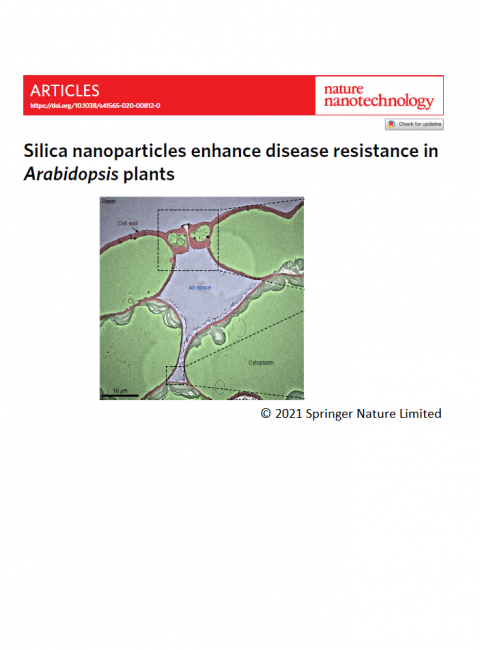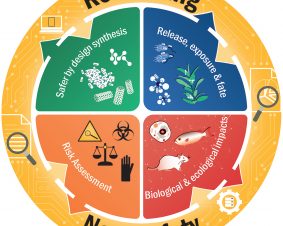 >
Spotlight December 2021: Silica nanoparticles improve plant disease resistance
>
Spotlight December 2021: Silica nanoparticles improve plant disease resistance
The resistance of plants to various pathogens is often increased in agriculture with various chemicals (“fertilizers”). A new direction is being taken with the use of nanoparticles. These can be sprayed on the plants. In the present study, the model plant Arabidopsis was used to investigate whether silicon dioxide nanoparticles (SiO2) can increase resistance to bacteria. For this purpose, plants were pretreated with silicon dioxide nanoparticles and then infected with bacteria. The plant hormone salicylic acid plays a major role in the defense against pathogens in plants. It is also used in human medicine as an antipyretic drug. Therefore, the content of salicylic acid in Arabidopsis leaves provided information about the protective function of silicon dioxide nanoparticles.
First of all, an uptake of the silicon dioxide nanoparticles via the pores of the leaves could be proven. Subsequently, a slow release of (ortho)silicic acid [Si(OH)4] occurs inside the leaves. (Ortho)silicic acid finally leads to the increased formation of salicylic acid by the plant, to which the actual protection against bacterial infections can be attributed. This shows that the administration of silicon dioxide nanoparticles was safer for the plant than the direct administration of (ortho)silicic acid. This is because the direct application of (ortho)silicic acid resulted in cellular stress responses, which were also visible by yellow leaves. In contrast, silicon dioxide nanoparticles in high concentrations showed no toxic effect, because the release of the effective (ortho)silicic acid is slow (depot effect). Only very small amounts of nanoparticulate silica are needed to exert a protective effect on the plant, making it a more cost-effective alternative comparing to other substances.
The authors caution that despite the beneficial properties of silicon dioxide nanoparticles for plant health, the long-term effects on farm workers, soil microorganisms and bees also need to be studied. Previous results with nematodes indicate a 36-fold lower toxicity of the nanoparticles, compared to liquid (ortho)silica. Thus, silica nanoparticles may be a safe and sustainable chemical for protection against plant diseases.
Original publication:
El-Shetehy M., Moradi A., Maceroni M., et al. Silica nanoparticles enhance disease resistance in Arabidopsis plants. Nat Nanotechnol. 2021;16(3):344-353. doi:10.1038/s41565-020-00812-0
More info on silica nanoparticles in our material text.

Weitere Spotlights
Spotlight Juli 2020: “Nanosafety – More than just regulatory processes”
Nanosafety is more than just a compulsory aspect of nanomaterials research and regulation. This research area also has great potential to drive new innovations. It is exactly this perspective that is addressed in the special issue “Rethinking Nanosafety: Harnessing Progress and Driving Innovation” by Chen et al. 2020. The article illustrates that especially in the field of […]
Read moreSpotlight November 2021: Safe Materials from Scratch – Safe-by-Design in Materials Research
Advances in the field of materials science continue to amaze us with nanoscale materials with extraordinary chemical, electrical, optical, and numerous other properties. However, some nanoscale materials have different toxicological profiles compared to the same bulk material. Since safety issues are usually addressed just before launching a product into the market, safety issues may be […]
Read moreSpotlight August 2023: From principles to reality. FAIR implementation in the nanosafety community
In the August 2023 Spotlight, we present a paper that addresses the implementation of FAIR (Findability, Accessibility, Interoperability and Reusability) Data in nanosafety research. The authors introduce the new AdvancedNano GO FAIR Implementation Network (see also https://www.go-fair.org/implementation-networks/overview/advancednano/) established as part of the GO FAIR initiative. The paper highlights the AdvancedNano GO FAIR Implementation Network’s support […]
Read moreSpotlight September: A methodology for the automatic evaluation of data quality and completeness of nanomaterials for risk assessment purposes
This paper describes a method for automatically assessing the quality and completeness of nanosafety data for the purpose of risk assessment. Steps to develop the methodology for assessing data completeness and the methodology for assessing quality are presented. The methodology is tailored to physicochemical and hazard (meta) data, but can also be configured with appropriate […]
Read more

